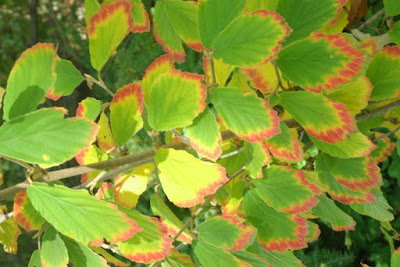Why this witch hazel (or any other witch hazel) should be in your garden
I admit I'm a lazy gardener when it comes to looking after my own little downtown Toronto garden. I compare it to the "cobbler's children have no shoes" adage: after a long and hot day weeding in a client's garden, not surprisingly doing the same in my backyard isn't appealing. As my garden has evolved over the 20 years, certain plants have consistently proven themselves by handling my benign neglect with aplomb (that is, not dying.) I'm sure you have your "winners" as well: it could be a peony transplanted from your parents' place or a houseplant that's travelled with you from your university days. They just keep plugging along with a bit of care.
 |
| Hamamelis x intermedia "Arnold Promise" witch hazel blooms |
 |
| Hamamelis x intermedia "Arnold Promise" witch hazel spring blooms |
For me, such a plant includes a witch hazel ( Hamamelis x intermedia "Arnold Promise" to be botanically exact) planted in the backyard garden about two decades ago. These late-winter blooming witch hazels of the Hamamelis x intermedia nomenclature are hybrids between Japanese witch hazel (H. japonica) and Chinese witch hazel (H. mollis). (Other cultivars to consider include "Jelena", "Diane", "Pallida" and "Primavera".)
Over the years, "AP" has bloomed faithfully every late winter here in Toronto (in some years as early as January, others March), putting out dozens of these yellow spidery and faintly fragrant flowers. Would other owners of these very early spring flowering shrubs not consider it strange sniffing these bizarre-looking flowers, standing in the snow, during a winter thaw? Not at all!
 |
| "Arnold Promise" Hamamelis x intermedia witch hazel flower |
 |
| "Arnold Promise" Hamamelis x intermedia witch hazel spring blooms |
These thin strap-like petals are much tougher than they look. Because the blooms occur in late winter, a cold snap inevitably occurs (consistent frost-free days and nights won't occur until May here in zone 5 Toronto). These witch hazel flowers handle the sub-zero temperatures by "shrivelling" up with the petals retracting, only to open up again with warmer days without any apparent damage. I think this is cool for any shrub!
 |
| "Arnold Promise" witch hazel blooms |
 |
| "Arnold Promise" witch hazel buds and bloom |
 |
| "Arnold Promise" witch hazel flowers |
Below is the "Arnold Promise" in our yard from last February. You may notice it's still holding on to its leaves from the previous season, which is a little unusual for most shrubs. Witch hazels are medium sized plants and can get to about 15' tall and 15' wide at maturity. I consider them to be slow to medium growers (annual growth rate) with an irregular branching structure or habit. I'd plant them in naturalized or informal settings like rain gardens or in part-shade gardens. Consider them a classic understory shrub planted with barrenwort, ferns, and other shady characters.
 |
| "Arnold Promise" witch hazel in my Toronto garden |
My witch hazel receives full sun until early afternoon, after which it is in the shadow cast by our neighbour's apartment. Since the plant is established, rootball-wise, regular watering isn't critical but young witch hazels prefer regular irrigation and loamy soil. I still need to water deeply during extended high heat periods which Toronto experienced last summer. Summer foliage consists of broad and clean green leaves with no mildew, rusts or holes, which is truly a blessing!
Witch hazels are hardy to zone 5 but I'd avoid planting them in exposed sites or xeriscapes. Think of an "understory" environment for a happier Hamamelis.
[Want to learn more about this shrub? Here's an excellent link from Missouri Botanical Garden: Hamamelis × intermedia 'Arnold Promise']
The fall foliage is also another wonderful attribute for this shrub that offers 3 plus season's worth of interest. These two pictures below are from a client's witch hazel. The leaves seem to be on fire!
 |
| "Arnold Promise" Hamamelis x intermedia fall foliage |
 |
| "Arnold Promise" witch hazel Hamamelis x intermedia fall foliage |
I'd describe scientifically my witch hazel's autumn colour as "intense tangerine" or "over ripe pumpkin orange." It combines sublimely with the golden and crimson fall foliage displays from the neighbouring Japanese maples and katsura trees.
I've lost many plants over the years due to verticillum wilt, scale, and viburnum leaf beetle just name a few reasons (painful to recall!) but this witch hazel is as horticulturally bullet-proof as they come. It hasn't been pestered by insects or diseases at all so I avoid all that spraying nonsense or seeing a prized (i.e., expensive) Japanese maple dying within weeks,
If you're looking for a shrub that's different from the run of the mill lilacs, hydrangeas, rhododendrons, etc. flooding your local garden centre's shelves this spring, I strongly suggest a witch hazel (if you can find one!). It's likely that you'll experience some sticker shock paying for a forlorn-looking stick in a container but planting a witch hazel is always a horticultural act of faith it seems.
In the meantime. my "Arnold Promise" witch hazel currently slumbering in the backyard will offer more mini-explosions of fragrant ripped-crepe paper petals soon and keep its promise that a Toronto spring isn't too far off.
No comments:
Post a Comment